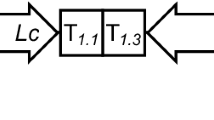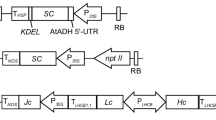Abstract
A functional comparison was made between a monoclonal secretory antibody generated in transgenic plants and its parent murine IgC antibody .The affinity constants of both antibodies for a Streptococcus mutans adhesion protein were similar. However the secretory antibody had a higher functional affinity due to its dimeric structure. In the human oral cavity, the secretory antibody survived for up to three days, compared with one day for the IgG antibody. The plant secretory antibody afforded specific protection in humans against oral streptococcal colonization for at least four months. We demonstrate that transgenic plants can be used to produce high affinity, monoclonal secretory antibodies that can prevent specific microbial colonization in humans. These findings could be extended to the immunotherapeutic prevention of other mucosal infections in humans and animals.
Similar content being viewed by others
References
Arntzen, C.J. High-tech herbal medicine: plant-based vaccines [news]. Nature Biotech. 15, 221–222 (1997).
Hiatt, A.C., Cafferkey, R. & Bowdish, K. Production of antibodies in transgenic plants. Nature 342, 76–78 (1989).
Ma, J.K-C. et al. Generation and assembly of secretory antibodies in plants. Science 268, 716–719 (1995).
Lehner, T., Caldwell, J. & Smith, R. Local passive immunization by monoclonal antibodies against streptococcal antigen I/II in the prevention of dental caries. Infect. Immun. 50, 796–799 (1985).
Ma, J.K., Smith, R. & Lehner, T. Use of monoclonal antibodies in local passive immunization to prevent colonization of human teeth by Streptococcus mutans . Infect. & Immun. 55, 1274–1278 (1987).
Ma, J.K-C., Hunjan, M., Smith, R., Kelly, C. & Lehner, T. An investigation into the mechanism of protection by local passive immunisation with monoclonal antibodies against Streptococcus mutans . Infect. Immun. 58, 3407–3414 (1990).
Ma, J.K-C., Lehner, T., Stabila, P., Fux, C.I. & Hiatt, A. Assembly of monoclonal antibodies with IgCl and IgA heavy chain domains in transgenic tobacco plants. Eur. J. Immunol. 24, 131–138 (1994).
Steward, M.W. & Chargelegue, D. Overview: Measurement and biological significance of antibody affinity and reactivity. In D.M. Weir, L.A. Herzenberg and C.C. Blackwell (eds.), Handbook of experimental immunology, Blackwell Scientific, Oxford, 1997, pp. 38.1.
Underdown, B.J. & Dorrington, K.J. Studies on the structural and conformational basis for the relative resistance of serum and secretory immunoglobulin A to proteolysis. J. Immunol. 112, 949–959 (1974).
Mestecky, J. & McGhee, J.R. Immunoglobulin A (IgA): molecular and cellular interactions involved in IgA biosynthesis and immune response. Adv. Immunol. 40, 153–245 (1987)
Corthesy, B. Recombinant secretory IgA for immune intervention against mucosal pathogens. Biochem. Soc. Trans. 25, 471–475 (1997)
Ma, J.K., Hunjan, M., Smith, R. & Lehner, T. Specificity of monoclonal antibodies in local passive immunization against Streptococcus mutans . Clin. Exper. Immunol. 77, 331–337 (1989)
Loe, H. & Silness, J. Periodontal disease in pregnancy. I. Prevalence and severity. Acta Odontol. Scand. 21, 532–551 (1963)
Silness, J. & Loe, H. Periodontal disease in pregnancy. II. Correlation between oral hygiene and periodontal condition. Acta Odontol. Scand. 22, 121–135 (1964)
Hajishengallis, G., Nikolova, E. & Russell, M.W. Inhibition of Streptococcus mutans adherence to saliva-coated hydroxyapatite by human secretory immunoglobulin A (S-lgA) antibodies to cell surface protein antigen I/II: reversal by IgAI protease cleavage. Infect. Immun. 60, 5057–5064 (1992)
Mazanec, M.B., Lamm, M.E., Lyn, D., Portner, A. & Nedrud, J.G. Comparison of IgA versus IgG monoclonal antibodies for passive immunization of the murine respiratory tract. Vir. Res. 23, 1–12 (1992)
Childers, N.K., Bruce, M.G. & McGhee, J.R. Molecular mechanisms of immunoglobulin A defense. Ann. Rev. Microbiol. 43, 503–536 (1989)
Mazanec, M.B., Nedrud, J.G., Kaetzel, C.S. & Lamm, M.E. A three-tiered view of the role of IgA in mucosal defense. Immunol. Today 14, 430–435 (1993)
Beighton, D., Russell, R.R. & Whiley, R.A. A simple biochemical scheme for the differentiation of Streptococcus mutans and Streptococcus sobrinus . Caries Res. 25, 174–178 (1991)
Zylber, L.J. & Jordan, H.V. Development of a selective medium for detection and enumeration of Actinomyces viscosus and Actinomyces naeslundii in dental plaque. J. Clin. Microbiol. 15, 253–259 (1982)
Author information
Authors and Affiliations
Rights and permissions
About this article
Cite this article
Ma, JC., Hikmat, B., Wycoff, K. et al. Characterization of a recombinant plant monoclonal secretory antibody and preventive immunotherapy in humans. Nat Med 4, 601–606 (1998). https://doi.org/10.1038/nm0598-601
Received:
Accepted:
Issue Date:
DOI: https://doi.org/10.1038/nm0598-601
- Springer Nature America, Inc.
This article is cited by
-
Prevention of Shiga toxin 1-caused colon injury by plant-derived recombinant IgA
Scientific Reports (2022)
-
Characterisation of a highly potent and near pan-neutralising anti-HIV monoclonal antibody expressed in tobacco plants
Retrovirology (2021)
-
Plant Platforms for Efficient Heterologous Protein Production
Biotechnology and Bioprocess Engineering (2021)
-
Engineering of Plants for Efficient Production of Therapeutics
Molecular Biotechnology (2021)





